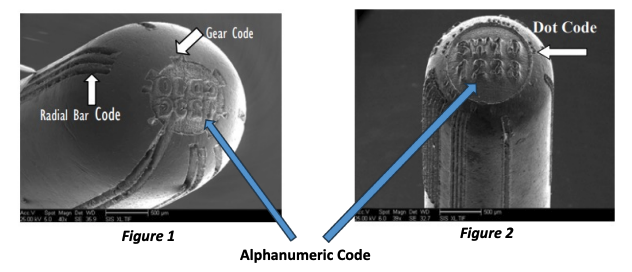The California Department of Justice (DOJ) has officially determined that microstamping is a viable technology, an important step that moves the state closer toward its upcoming deadline for all semi-automatic pistols to be sold with special firing pins that engrave unique identification codes, or “microstamps,” onto the backs of cartridge casings before they are ejected from the gun. Thus, if police recover microstamped casings from crime scenes, they may be able to identify the perpetrator — even if the gun itself is never recovered.
According to the California DOJ report, “engraved firing pins can impart a legible microstamp on expended cartridge cases with regularity, including after sustained or repeat firing.”
The findings directly contradict claims made by the gun industry’s trade association, the National Shooting Sports Foundation (NSSF), which has repeatedly said that microstamping is not “ready for prime time.” The NSSF has spent decades opposing the crime-solving tool, despite numerous endorsements from law enforcement agencies over the years.
CALIFORNIA’s MICROSTAMPING INVESTIGATION
Enacted in 2023, Senate Bill 452 required the California DOJ to investigate the technological viability of microstamping. As part of its investigation, the agency tested two pistols — a 9mm Glock 43 and a .45-caliber Smith & Wesson 1911 — with microstamped firing pins provided by TACLABS, a company founded by the inventors of the technology, which they call “intentional firearm microstamping.” The California DOJ’s Bureau of Forensic Services (BFS) examined 10 spent casings from each pistol and determined that they had been successfully marked with identifiable microstamps.

The California DOJ also reviewed New Jersey’s own microstamping investigation — which involved more live-fire testing and yielded similar results in February 2024 — as well as studies dating back to 2006 which found that a range of microstamping-enabled pistols imprinted legible identification codes on a majority of spent casings.
While some critics of microstamping insist that the technology is not 100-percent “perfect” all of the time, the California DOJ report noted that “even a partial microstamp can provide very valuable investigative information that can be used to help solve and prosecute crimes, analogous to investigators receiving a partial license plate from a vehicle or a partial fingerprint from a crime scene. Even when the evidentiary information is not 100 percent complete, it may aid in narrowing down the possibilities and developing probabilistic leads and evidence.”
Ultimately, the California DOJ said that microstamping “could provide one additional investigatory and evidentiary tool available to complement other tools used to identify a possible suspect and build and prove a criminal case.”
solving more firearm crimes
According to California Attorney General Rob Bonta’s office, now that the California DOJ has found microstamping viable, Senate Bill 452 requires that the agency “develop performance standards for entities that produce microstamping components,” which are expected this fall. The agency will begin accepting applications for businesses to obtain licenses to produce microstamping components starting “early next year.”
Senate Bill 452 ultimately requires that pistols sold by licensed dealers after January 1, 2028, “must be verified as microstamping enabled, if DOJ determines that microstamping components are available at commercially reasonable prices or that microstamping-enabled firearms are otherwise readily available for purchase.”
As of this writing, the NSSF has not responded to the California DOJ report. But the group is likely to denounce it. After California’s then-Attorney General Kamala Harris certified that microstamping was viable in May 2013 and required on any new pistols sold in the state as part of the Crime Gun Identification Act of 2007, the NSSF immediately sued, alleging that microstamping was “impossible to implement.” While that challenge was eventually dismissed, another filed by the National Rifle Association’s California state affiliate is still ongoing.
Senate Bill 452 was enacted as a way to maneuver around the gun industry’s refusal to adopt microstamping, as it provides an avenue for pistols to be modified with microstamped firing pins post-manufacture if gun makers fail to raise their standards and aid law enforcement.